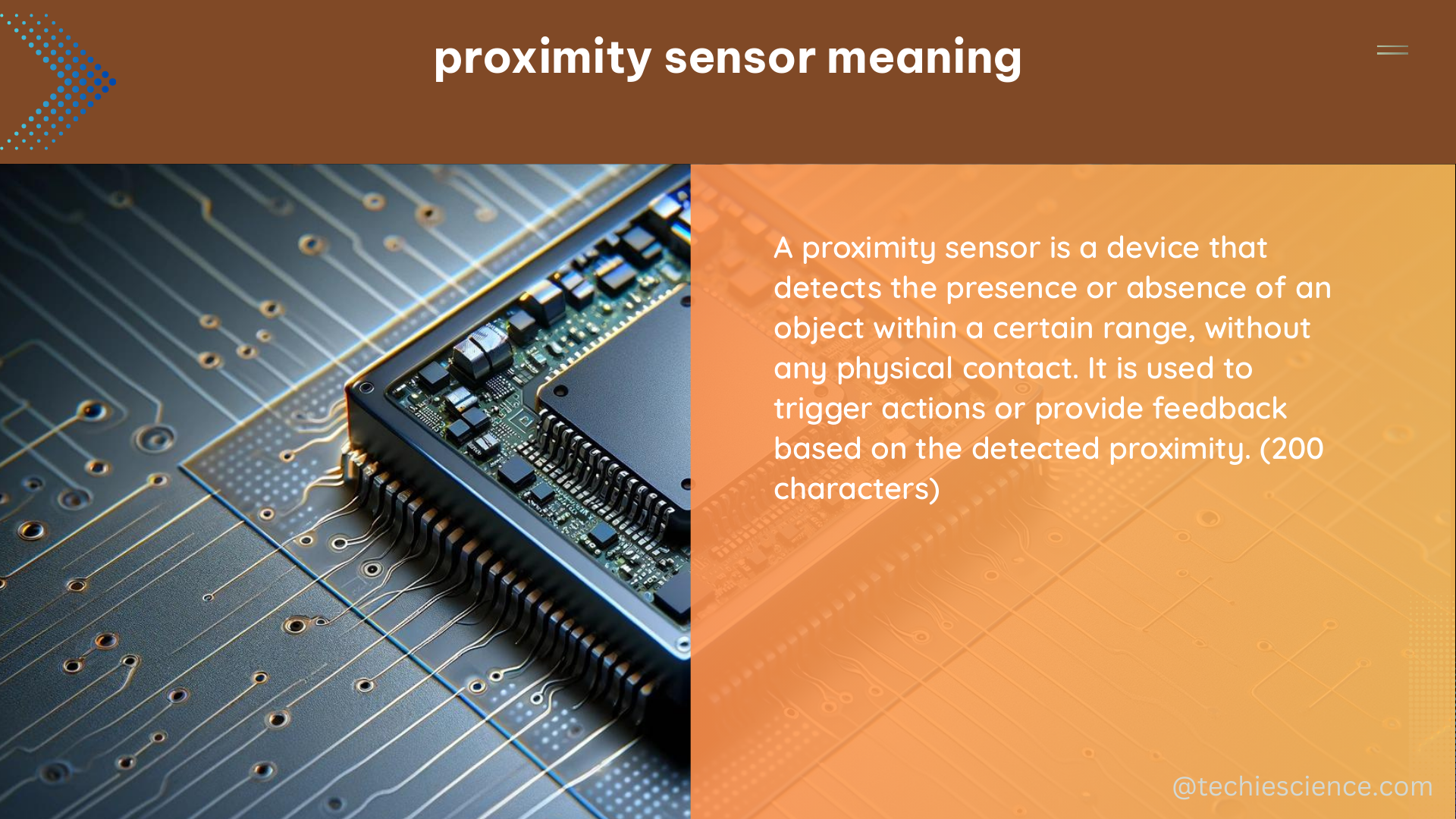Proximity sensors are devices that detect the presence or absence of an object within a certain range without physical contact. These sensors operate on the principle that objects can affect the field emitted or received by the sensor, such as infrared, ultrasonic, or radio-frequency waves. The technical specifications of proximity sensors can vary significantly depending on the type and application, making them a versatile tool in various industries.
Understanding Proximity Sensor Types and Specifications
Infrared Proximity Sensors
Infrared proximity sensors typically have the following specifications:
– Measurement range: 1 cm to 1 m
– Angular field of view: 15 to 90 degrees
– Response time: less than 10 ms
These sensors work by emitting infrared light and detecting the reflection from nearby objects. The intensity of the reflected light is used to determine the presence and distance of the object.
Ultrasonic Proximity Sensors
Ultrasonic proximity sensors can detect objects at a range of up to 5 m, with the following specifications:
– Measurement range: up to 5 m
– Angular field of view: 30 to 90 degrees
– Response time: around 10 ms
Ultrasonic sensors work by emitting high-frequency sound waves and measuring the time it takes for the waves to reflect off an object and return to the sensor.
Capacitive Proximity Sensors
Capacitive proximity sensors can detect objects made of various materials, including metals and non-metals, with the following specifications:
– Measurement range: up to 30 cm
– Angular field of view: 30 to 180 degrees
– Response time: less than 1 ms
Capacitive sensors work by creating an electrostatic field and detecting changes in the field caused by the presence of an object.
Proximity Sensor Meaning DIY

Building a simple infrared proximity sensor is a popular DIY project. This can be done using an IR LED and a phototransistor. The LED emits infrared light, which is reflected back by an object and detected by the phototransistor, triggering a response.
To create a DIY infrared proximity sensor, you’ll need the following components:
– IR LED
– Phototransistor
– Resistors
– Breadboard or PCB
– Jumper wires
– Microcontroller (e.g., Arduino, Raspberry Pi)
The basic circuit can be constructed as follows:
1. Connect the IR LED to the microcontroller’s digital output pin.
2. Connect the phototransistor to the microcontroller’s analog input pin.
3. Add a pull-up or pull-down resistor to the phototransistor’s base.
4. Write a program to read the analog input from the phototransistor and detect changes in the reflected infrared light.
By adjusting the distance between the IR LED and the object, you can calibrate the proximity detection range of your DIY sensor.
Quantifiable Data on Proximity Sensor Meaning
To provide quantifiable data on proximity sensor meaning, consider the following example:
A study using wearable proximity sensors to characterize social contact patterns in a rural village in Malawi found that:
– Sensors in close proximity exchanged an average of 1 power packet per second.
– The exchange of low-power radio-packets was used as a proxy for spatial proximity.
– The attenuation of signals with distance was computed as the difference between the received and transmitted power.
– Proximity between individuals was asserted when the median attenuation over a given time interval exceeded a specified attenuation threshold (-75 dBm), allowing the detection of proximity events between devices situated in the range of 1-1.5 m of one another.
This study demonstrates how quantifiable data can be obtained from proximity sensors to understand social interactions and spatial relationships.
Conclusion
Proximity sensors are versatile devices that can detect the presence or absence of objects without physical contact. By understanding the different types of proximity sensors and their technical specifications, you can choose the right sensor for your application and even build your own DIY proximity sensor. The quantifiable data obtained from proximity sensors can provide valuable insights into various scenarios, from social interactions to industrial automation.
References:
- Using wearable proximity sensors to characterize social contact patterns in a rural village in Malawi. EpJ Data Sci (2021) 10:30. https://doi.org/10.1140/epjds/s13688-021-00302-w
- Proximity Data – an overview | ScienceDirect Topics. https://www.sciencedirect.com/topics/computer-science/proximity-data
- Sensor System – an overview | ScienceDirect Topics. https://www.sciencedirect.com/topics/materials-science/sensor-system
- Sensor-based proximity metrics for team research. A validation study across three organizational contexts. PMC8062328. https://doi.org/10.1186/s41010-021-00165-4
- What is Quantitative Data? [Definition, Examples & FAQ]. https://careerfoundry.com/en/blog/data-analytics/what-is-quantitative-data/

The lambdageeks.com Core SME Team is a group of experienced subject matter experts from diverse scientific and technical fields including Physics, Chemistry, Technology,Electronics & Electrical Engineering, Automotive, Mechanical Engineering. Our team collaborates to create high-quality, well-researched articles on a wide range of science and technology topics for the lambdageeks.com website.
All Our Senior SME are having more than 7 Years of experience in the respective fields . They are either Working Industry Professionals or assocaited With different Universities. Refer Our Authors Page to get to know About our Core SMEs.